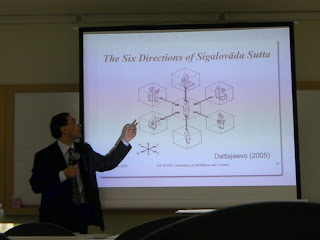On 19 November, exactly one month ago, I joined an informal pilgrimage organised by my temple friend, Kalyanamitra P' Jo. It was to visit the major sites associated with Bhikkhu Sodh Candasaro, widely known as the great meditation master, Luang Phor Wat Paknam (or Luang Pu Wat Paknam), who rediscovered the Dhammakaya method of meditation. (Luang Phor is a respecful term of address, something like "Revered Father"; Luang Pu simply extends by one generation: "Revered Grandfather").
I was picked up at my apartment along the Taksin Road, near to Wongwienyai. As it is in Thonburi, the first stop was arranged as Wat Paknam, which is only two or three miles away.
This wat continues to develop and on this occasion there was an exhibition of its history, centred around its most famous abbot. As is the general custom, we went up to pay respects to Luang Pu in his shrine room, where his body lies in state. I've been there quite a few times and on each occasion I've noticed people sitting in meditation around the edges; its atmosphere is conducive to focusing the mind.
Whilst there I was wondering if anyone might know about my mother or, at least, her teacher, Ajahn Gaew. After a while we found a maechi, who kindly received us in between her various other guests. She had been at the Wat for over 60 years and so was there at the time of the late abbot and knew about all the well-known teachers, including Khun Yay Jan and Ajahn Gaew. Despite her years, she had tremendous energy and I felt her meditation practice was highly developed.
Ever since Luang Phor Wat Paknam took charge and remained incumbent until his passing in 1959, the temple has flourished in various ways. In recent decades it has been under the direction of Somdet Phramaharajamongkolajarn, who has been particularly active in the field of education, but the temple still continues to promote the Dhammakaya method. The abbot has given a lot of support to programmes at Wat Phra Dhammakaya, including the annual rains retreat ordination, over which he presides.
We proceeded to Nakhon Pathom, famous for Phra Pathom Chedi (for which I've made notes from an earlier visit, but we were already running behind schedule, and needed some sustenance: next stop lunch! We made our way to the 'floating market' of Don Wai, a very popular destination with locals, which is usually exceedingly crowded at weekends. It's not really floating, but just looks over the river. The growing prominence of environmental concerns has been having an impact on festival celebrations: hence the following bio-degradable floats for the Loy Kratong festival, produced by a bakery:
We continued the pilgrimage to Wat Bot Bon Bangkuwien, the small temple where Luang Pu first attained to Dhammakaya. It's located in Nonthaburi. It's now quite well known, so is well maintained, but it is still takes a bit of effort to locate: one of my cousins and her husband live in Nonthaburi, not far away from this Wat, but they had never managed to find it until I assured them that it was nearby. I couldn't remember the route to direct them, but there was enough impetus for them to make a renewed effort and we could duly reach it safely.
Back to the present pilgrimage, the main chapel has an interesting array of Buddha rupas, conveying the sense of pervading all directions:
We paid respects, sat briefly in meditation, offered a garland, and continued on our way.
The next leg took us to Suphan Buri province and two sites. The first was Wat Songphinong (literally the temple of the two siblings), where the young man Sodh Mikaewnoi ordained as Bhikkhu Candasaro and so began his quest in earnest to search for the heart of the Buddha's teaching.
It's another flourishing temple with a new vihara and uposatha:
The temple itself is on a site that has Buddhist roots going back more than 1,000 years, with the ruibs of a Khmer chedi from around the 8th century - according to a study guide of the Central plain.
As previously, we paid respects, leaving a garland at the shrine of Luang Pu:
From Wat Songphinong it was a short hop to the birthplace of Luang Pu, though it required a bit of careful navigation as there was still quite a lot of flooding in the area:
Fortunately the waters had receded sufficiently to enable us to keep to our itinerary and after walking across some sandbags, we reached the memorial grounds of the birthplace. The Mikaewnoi family home has gone, but at that spot there is a candle or beacon situated at the centre of a circular pool, evoking the symbol of radiating light.
Nearby is another symbol, very familiar to meditators, that of a giant sphere:
Beyond the sphere lies the memorial hall, though it was not yet complete:
There was one other destination for us in Suphan Buri: Wat bangpla, Banglain, where Luang Pu first gave teachings on the Dhammakaya method. As with the other Wats, it appears to be prospering and retains a mixture of old and new
After 4 months there it was said that 3 monks and 4 lay people attained Dhammakaya and from there Candasaro Bhikkhu continued to spread the teaching and the tradition grew.
To complete the day, we proceeded to Wat Phra Dhammakaya in Pathum Thani, where I helped a monk practise his English, taking the opportunity to ask him a few questions that have arisen during the course of my academic studies.
I was ferried back to Thonburi and so ended a full and fulfilling day of pilgrimage in honour of a great meditation master, the founder of the present Dhammakaya tradition.

